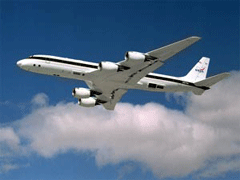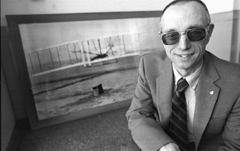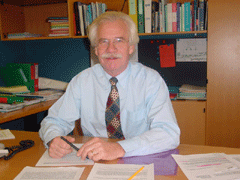Airline Emissions Fly High
Air Date: Week of March 9, 2007

(Courtesy of NASA)
The airline industry makes up two percent of the world’s CO2 emissions, but at 27,000 feet in the sky those emissions pack more of a punch than they would at ground level. Living on Earth’s Ashley Ahearn reports on the industry’s slow flight to a green future.
Transcript
GELLERMAN: From the Jennifer and Ted Stanley Studios in Somerville, Massachusetts this is Living on Earth. I’m Bruce Gellerman, sitting in for Steve Curwood. Look up in the sky—it’s a bird, it’s a plane actually, it’s 15,000 airplanes.
That’s the number of planes flying in the air at any given time, and that doesn’t even include private jets. Government officials predict by 2025, the number of planes in the sky will soar three-fold. That’s bad news for the environment because more flights mean more global warming gases spewed into the atmosphere.
Living on Earth’s Ashley Ahearn reports cleaner fuels and aircraft are on the horizon but, like many flights, they may be delayed.
[MUSIC: Kenny Loggins “Danger Zone (Theme from ‘Top Gun’)” from ‘The Essential Kenny Loggins’ (Sony Music - 1972)]
AHEARN: The movie is Top Gun. Think Tom Cruise and Val Kilmer as young fighter pilots, vying for stud status at the Navy’s top pilot school.
[SOUNDS FROM THE MOVIE]
AHEARN: But whether we’re talking about military jets, or the 737 you take on business or to visit grandma, aircraft engines are a significant source of emissions.
Dr. Dennis Bushnell, chief scientist for NASA’s Langley Research Center explains.
BUSHNELL: Airplanes nominally produce, in terms of carbon dioxide, something like 3.5 to 4 to 5 percent of the total CO2.

Dennis Bushnell is Chief Scientist at NASA's Langley Research Center. (Couresty of NASA/Langley Research Center)
Bushnell says CO2 is only part of the way airline travel contributes to global warming. The water vapor from planes is also a big problem because it forms extra clouds, which trap heat.
BUSHNELL: This is deposited at altitude where the predictions are that it’s like three to five times more important in terms of a global warming impact.
AHEARN: Three to five times more than if these gases were released at ground level.
Flying is also a big part of our personal carbon footprint. I wanted to see just how big, so I went to Al Gore’s carbon footprint calculator on the web.
AHEARN: [TYPING SOUNDS] Ok, so I probably drive about 2000 miles a year. And my average heating bill is 75-100; it’s been pretty cold lately. That puts me at 9 tons of carbon emitted per year.
So now lets see what happens if I fly. Let’s say I take three, no two short flights, that’s like flying to Florida I guess from Boston, and then we’ll say one medium flight. And then one long haul, not that I can afford to go to Europe on a regular basis, but you know, we’ll just put it in there for fun. That boosted my carbon by two tons per year.
AHEARN: So if I fly four times a year, my CO2 emissions go up by 22 percent.

(Courtesy of NASA)
ROCHAT: The technology is improving. Each new aircraft, new engine, is an improvement vis a vis the previous one. People are already working and considering this very long-term solution for aviation.
AHEARN: NASA’s Dennis Bushnell agrees major technological advancements are on the horizon, but he says the industry’s not moving fast enough to get there.
BUSHNELL: They’re talking about at the most 50% reductions in CO2 by evolutionarily fiddling around with the current machines and that will hardly account for the expected growth in air travel.
AHEARN: The number of tickets sold each year is set to double by 2025.
And when it comes to the possibility of replacing jet fuel, which is actually kerosene, with biofuel, there’s a bit of jet lag. Ethanol, for example, doesn’t pack as much energy as jet fuel, and biofuels tend to freeze at high altitudes.
In the European Union there’s a move to limit aircraft emissions by adding the airline industry to its carbon trading plan by 2011. But the airline industry says only a global solution would avoid putting certain carriers at a disadvantage.
ROCHAT: We believe that since aviation is a global industry and since airlines fly all over the world, only a global emissions trading scheme is able let’s say to cover all flights and to avoid discrimination, to avoid distortion of competition between airlines.

Phillipe Rochat is the Director of the Aviation Environment Department at the International Air Transport Association. (Courtesy of the International Air Transport Association)
AHEARN: Aviation emissions is now a major topic of debate in Europe. Politicians there and beyond, from Tony Blair to Arnold Schwarzenegger increasingly find themselves on the defensive over their frequent flights.
Some airlines have publicly responded. British Airways, Virgin-Atlantic, and Easyjet have committed to reducing their emissions and boosting fuel efficiency. But for some critics, that’s not fast enough and they’re taking matters into their own hands.
John Valentine is a stonemason from London. Last year he started a web campaign called flight pledge to get people to cut back on the amount of time they spend in the air.
VALENTINE: They log into the website and they make a pledge and in return for that promise the computer sends back a little certificate which they can print off and put on their toilet wall or whatever they want to do with it.
AHEARN: Valentine says he has more than 1500 members, most of whom are British. Not an international campaign perhaps, but it’s a gradual process.
VALENTINE: Then you’ve nibbled away at it, and I think just everybody has to make a wee bit of an effort. This is why the website doesn’t ask people to sort of forswear flying forever it says if you’re just going to do two flights a year, then that’s great.
AHEARN: For most of us, flying is still an unavoidable part of the way we get around. But for John Valentine’s next holiday in the South of France, he’ll be taking the train.
For Living on Earth, I’m Ashley Ahearn.
Links
International Air Transport Association
Living on Earth wants to hear from you!
Living on Earth
62 Calef Highway, Suite 212
Lee, NH 03861
Telephone: 617-287-4121
E-mail: comments@loe.org
Newsletter [Click here]
Donate to Living on Earth!
Living on Earth is an independent media program and relies entirely on contributions from listeners and institutions supporting public service. Please donate now to preserve an independent environmental voice.
NewsletterLiving on Earth offers a weekly delivery of the show's rundown to your mailbox. Sign up for our newsletter today!
 Sailors For The Sea: Be the change you want to sea.
Sailors For The Sea: Be the change you want to sea.
 The Grantham Foundation for the Protection of the Environment: Committed to protecting and improving the health of the global environment.
The Grantham Foundation for the Protection of the Environment: Committed to protecting and improving the health of the global environment.
 Contribute to Living on Earth and receive, as our gift to you, an archival print of one of Mark Seth Lender's extraordinary wildlife photographs. Follow the link to see Mark's current collection of photographs.
Contribute to Living on Earth and receive, as our gift to you, an archival print of one of Mark Seth Lender's extraordinary wildlife photographs. Follow the link to see Mark's current collection of photographs.
 Buy a signed copy of Mark Seth Lender's book Smeagull the Seagull & support Living on Earth
Buy a signed copy of Mark Seth Lender's book Smeagull the Seagull & support Living on Earth

